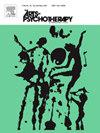Aesthetic distance: Conceptualization and practical use
IF 1.5
3区 心理学
Q3 PSYCHOLOGY, CLINICAL
引用次数: 0
Abstract
Drama therapy is an experiential psychotherapy method utilizing theatrical elements to facilitate psychological growth and change. "Aesthetic distance," a core concept in drama therapy, refers to the midpoint between cognitive detachment and emotional over-engagement, allowing individuals to simultaneously think about and feel their experiences. This balance enables people to experience a situation both from within and as an external observer, integrating emotional and cognitive processes. This qualitative study explored the conceptualization and application of aesthetic distance by conducting semi-structured interviews with 20 experienced drama therapists and psychodramatists. Deductive data analysis revealed five themes: (a) aesthetic distance is a multilayered, multidimensional term; (b) The assessment of different states of aesthetic distance can be done via various expressions; (c) there are different avenues to reach aesthetic distance; (d) being in aesthetic distance may enable clients to access sensitive content and experience transformation; and (e) The therapist’s own engagement with the state of aesthetic distance is an important factor in the therapeutic process. Based on these findings, we developed an integrative model encapsulating the use of aesthetic distance in therapy, including its role in assessment, intervention planning, as a catalyst for change, and as a therapeutic outcome. The model also highlights the therapist's pivotal role in cultivating aesthetic distance and its impact on both therapist and client. This study contributes to a more comprehensive understanding of aesthetic distance as a cognitive-emotional construct, offering insights that can inform and enhance clinical practice in drama therapy and related fields.
审美距离:概念化与实用化
戏剧疗法是一种利用戏剧元素来促进心理成长和变化的体验性心理治疗方法。“审美距离”是戏剧治疗的核心概念,是指认知超然和情感过度投入之间的中点,使个体能够同时思考和感受自己的经历。这种平衡使人们能够从内部和外部观察者的角度来体验一种情况,整合情感和认知过程。本质性研究通过对20位经验丰富的戏剧治疗师和心理戏剧家进行半结构化访谈,探讨审美距离的概念化和应用。演绎数据分析揭示了五个主题:(a)审美距离是一个多层次、多维的术语;(b)对不同审美距离状态的评价可以通过不同的表达方式来完成;(c)有不同的途径达到审美距离;(d)保持审美距离可以让客户接触到敏感内容和体验转变;(e)治疗师自己对审美距离状态的参与是治疗过程中的一个重要因素。基于这些发现,我们开发了一个综合模型,概括了美学距离在治疗中的应用,包括其在评估、干预计划、作为变革催化剂和作为治疗结果中的作用。该模型还强调了治疗师在培养审美距离方面的关键作用及其对治疗师和来访者的影响。本研究有助于更全面地了解审美距离作为一种认知-情感建构,为戏剧治疗及相关领域的临床实践提供信息和促进。
本文章由计算机程序翻译,如有差异,请以英文原文为准。
求助全文
约1分钟内获得全文
求助全文
来源期刊

Arts in Psychotherapy
Multiple-
CiteScore
3.20
自引率
11.10%
发文量
66
期刊介绍:
The Arts in Psychotherapy is a dynamic, contemporary journal publishing evidence-based research, expert opinion, theoretical positions, and case material on a wide range of topics intersecting the fields of mental health and creative arts therapies. It is an international peer-reviewed journal publishing 5 issues annually. Papers are welcomed from researchers and practitioners in the fields of art, dance/movement, drama, music, and poetry psychotherapy, as well as expressive and creative arts therapy, neuroscience, psychiatry, education, allied health, and psychology that aim to engage high level theoretical concepts with the rigor of professional practice. The journal welcomes contributions that present new and emergent knowledge about the role of the arts in healthcare, and engage a critical discourse relevant to an international readership that can inform the development of new services and the refinement of existing policies and practices. There is no restriction on research methods and review papers are welcome. From time to time the journal publishes special issues on topics warranting a distinctive focus relevant to the stated goals and scope of the publication.
 求助内容:
求助内容: 应助结果提醒方式:
应助结果提醒方式:


